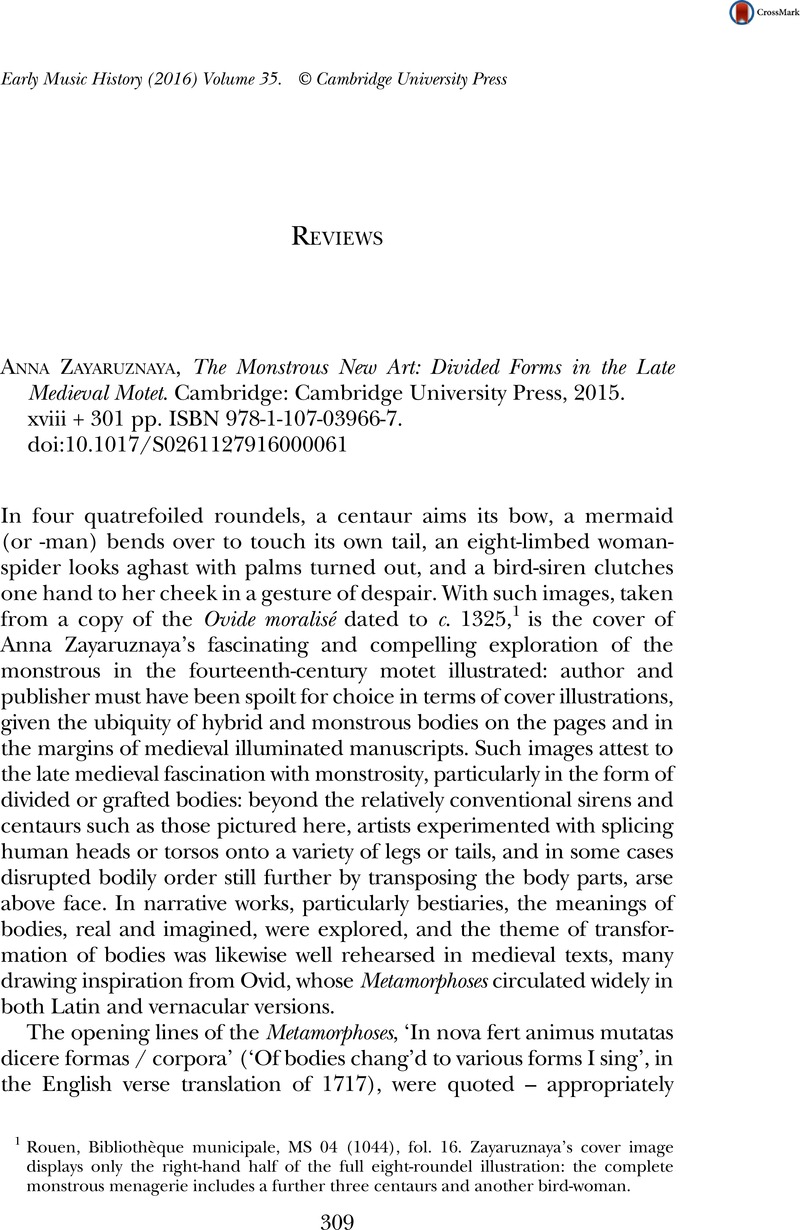No CrossRef data available.
Article contents
Anna Zayaruznaya, The Monstrous New Art: Divided Forms in the Late Medieval Motet. Cambridge: Cambridge University Press, 2015. xviii + 301 pp. ISBN 978-1-107-03966-7.
Published online by Cambridge University Press: 28 September 2016
Abstract

- Type
- Reviews
- Information
- Copyright
- © Cambridge University Press 2016
References
1 Rouen, Bibliothèque municipale, MS 04 (1044), fol. 16. Zayaruznaya’s cover image displays only the right-hand half of the full eight-roundel illustration: the complete monstrous menagerie includes a further three centaurs and another bird-woman.
2 I choose the term ‘receivers’ quite deliberately, as a way of acknowledging that in certain contexts – then and now – motets are and were encountered initially or partially (if not exclusively) through reading rather than through listening.
3 The positions of these authors are outlined, respectively, in Page, C., Discarding Images: Reflections on Music and Culture in Medieval France (Oxford and New York: Oxford University Press, 1993)Google Scholar and Dillon, E., The Sense of Sound: Musical Meaning in France, 1260–1330 (New York and Oxford: Oxford University Press, 2012)CrossRefGoogle Scholar.
4 Margaret Bent’s approach is apparent in her articles ‘Words and Music in Machaut’s Motet 9’, Early Music, 31 (2003), pp. 363–88, and ‘Polyphony of Texts and Music in the Fourteenth-Cenutry Motet: Tribum que non abhorruit/Quoniam secta latronum/Merito hec patimur and its “Quotations”’, in Pesce, D. (ed.), Hearing the Motet: Essays on the Motet of the Middle Ages and Renaissance (New York and Oxford: Oxford University Press, 1997), pp. 82–103 Google Scholar, and similar approaches have been adopted in the work of other authors cited by Zayaruznaya on pp. 9–10.
5 The implications of these formal elements in terms of agency and subjectivity are expounded more fully by Peraino, J. A. in Giving Voice to Love: Song and Self-Expression from the Troubadours to Guillaume de Machaut (New York and Oxford: Oxford University Press, 2011), pp. 33–75 CrossRefGoogle Scholar.
6 Page, C., ‘Johannes de Grocheio on Secular Music: A Corrected Text and New Translation’, Plainsong and Medieval Music, 2 (1993), pp. 17–41 CrossRefGoogle Scholar, at p. 36. Fuller discussion of Grocheio’s use of the term ‘litterati’ in this passage can be found in Page, Discarding Images, ch. 3.
7 The other, the English motet Sub Arturo/Fons, has been variously dated and may be a fifteenth-century work; see p. 210, n. 61.
8 The interesting parallels that this opens up with the much more prevalent practice of citation within the motets of the thirteenth century deserve further scrutiny, though this was doubtless beyond the (already extensive) scope of the book.
9 This practice has been explored by Huot, Sylvia in Allegorical Play in the Old French Motet: The Sacred and the Profane in Thirteenth-Century Polyphony (Stanford, Calif.: Stanford University Press, 1997)Google Scholar.
10 ‘Writing, Performance, and Devotion in the Thirteenth-Century Motet: The ‘La Clayette’ Manuscript’, in Deeming, H. and Leach, E. E. (eds.), Manuscripts and Medieval Song: Inscription, Performance, Context (Cambridge: Cambridge University Press, 2015)CrossRefGoogle Scholar, pp. 193–220, at p. 194.
11 Such research in the future will be facilitated by the publication of results from the Cantum pulcriorem invenire project led by Mark Everist (http://catalogue.conductus.ac.uk/), which will culminate in a forthcoming book on the conductus.
12 In a few places, some aspects of the typography could have been adjusted for maximum benefit to the reader: original texts and their translations are sometimes separated from one another over page-breaks, and figures are not always ideally placed. The worst instance of this is Fig. 1.3 and Fig 1.3 (cont.), two facing folios from F-Pn fr. 146 that need to be viewed together, as an opening, but are here printed on the front and back sides of the same page: aspects of the argument here rest on a visual appreciation of the opening as a whole, such that the reader would be well advised to consult the digital facsimile on Gallica at this juncture instead: http://gallica.bnf.fr/ark:/12148/btv1b8454675g/f104.double.r=francais%20146.
13 Consequently, proof-reading errors that hinder comprehension at the densest moments of the analyses are particularly unfortunate: one such is on p. 85 (‘per collum’ for ‘per nichil’), and another in the score of In virtute/Decens in Appendix 1, where the triplum has ‘cuiplumas’ for ‘cui plumas’, a material point as the analysis of this section rests on readers’ appreciation of where the word-breaks actually lie.


